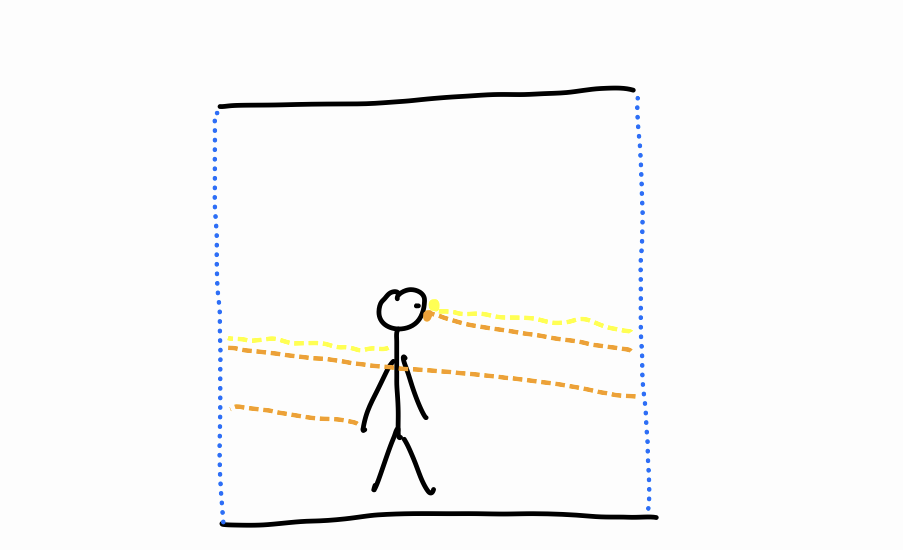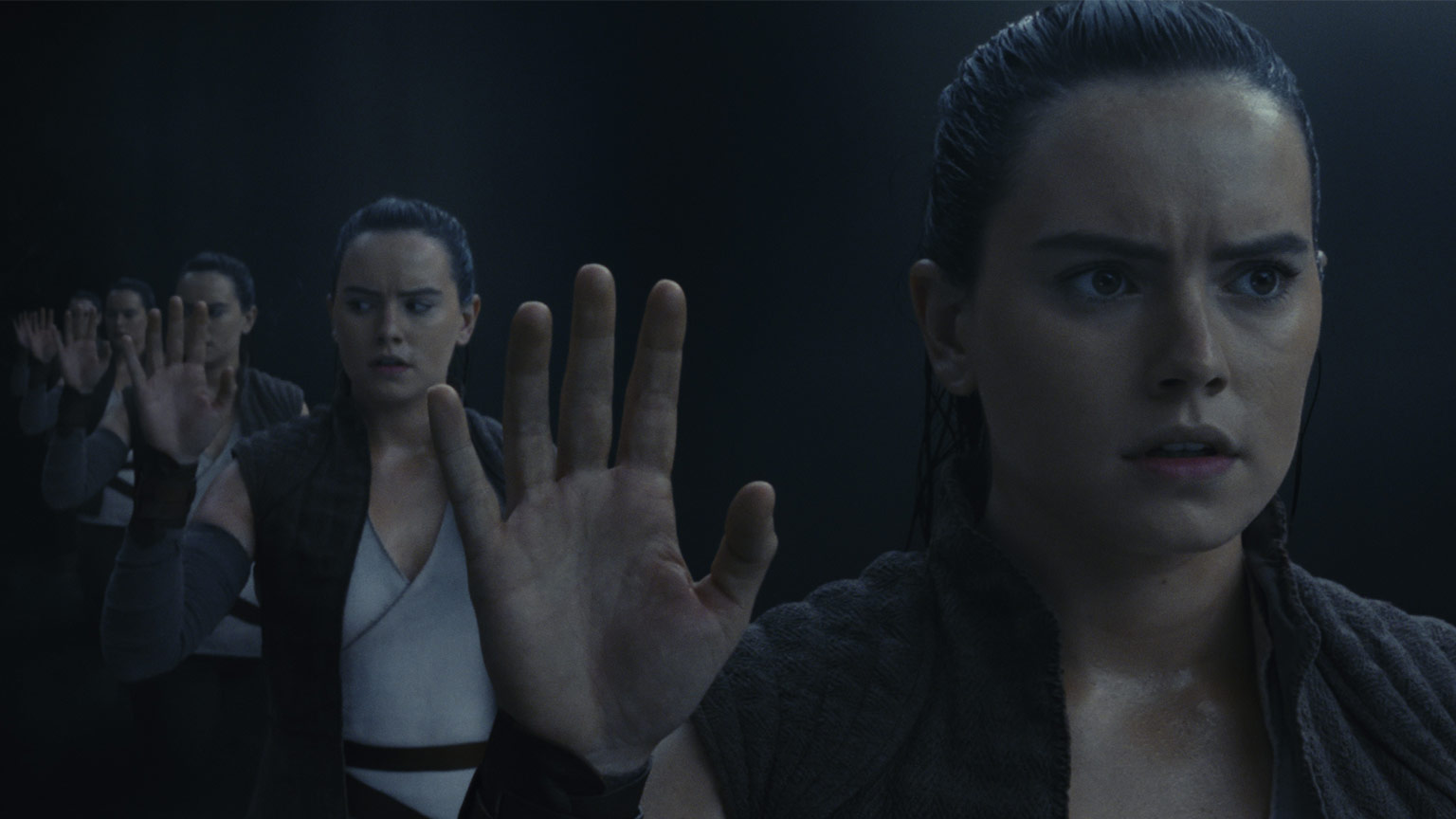The Periodic Box Problem
Here is an interesting thought experiment I came up with that brings up some deep questions about metaphysics and identity. To start with, consider the following two scenarios.
Scenario 1
The entire universe consists of a rectangular box, which you are trapped in. Four of the faces – the floor, the ceiling, and the left and right walls – are solid metal and cannot be tampered with. However, the front and back faces (which are, say, 5 feet apart) act as portals that instantaneously transport objects between each other. If you were to throw a baseball through the front portal, it would instantly pop out of the back portal at the same height, lateral position, and velocity.

Because of this, you find yourself trapped inside the box. Any time you try to leave through the front or the back, you just reappear on the other side. You can even stick half of your body through the portal at a time. You won’t even feel anything unusual about your body being split into two discontiguous parts because all of the blood flow and nerve signals pass will freely between the portals.1 If your arms are long enough, you can even reach forward and tap the back of your head, or high-five yourself by spreading out your arms.
In fact, since photons also get teleported between the portals, if you look forward you see yourself from the back, appearing one box length (5 feet) away! This image comes from photons bouncing off your back, traveling through the back portal, and then hitting your eyes. You can also see another image of yourself standing 10 feet away, corresponding to photons that bounce off your back, travel through the back portal, go through the entire box to take the back portal again, and then hit your eyes. You would see similar images for photons that take the portal three times, four times, and so on.

The yellow photon forms the image of yourself 5 feet away, and the orange photon forms the image of yourself 10 feet away. The orange photon doesn't pass through your body, it just looks like that when drawn in two dimensions.
This means you have the illusion of seeing an infinite line of copies of yourself, separated by five feet each. It is a similar visual experience to standing between two perfect mirrors, except all images of yourself are facing in the same direction. You can’t see the portal itself (it doesn’t have any magical shimmer or anything) or even determine its location through any experimental means. In fact, this entire scenario could be interpreted as space itself being curved – the volume of a torus instead of a rectangular prism – no portals necessary.2 Now let’s look at the next scenario.
Scenario 2
The entire universe now consists of a metal hallway, extending infinitely in both directions. You are in this hallway, along with infinitely many copies of you, spaced out by 5 feet each. These are identical copies of you, down to the atom. In fact, these copies of you are placed in such a way that the entire universe is periodic. In other words, the distribution of matter and energy in any 5-foot subsection is identical to the distribution of matter and energy in the next 5-foot subsection, and so on. Alternatively, if you let \(f(x)\) represent the cross-section of the hallway at position \(x\) (where \(x\) ranges length-wise along the hallway), then \(f(x) = f(x+5)\).

If you’ve watched Star Wars: The Last Jedi, this is essentially what Rey experiences in her visit to the “mirror cave” (although in the movie there’s a bit of lag between her actions and her clones’ actions):

The "mirror cave" scene from Star Wars: The Last Jedi.
For the purposes of this thought experiment, let’s assume the universe is deterministic. The state of the universe at time \(t+1\) is completely determined by the state of the universe at time \(t\). We’ll just ignore weird quantum randomness and problems with free will for now 3. Since your actions are determined by your brain state, which in turn is controlled by physical laws that affect all of your clones’ brains identically, your clones will all act in the exact same way as you. Every time you have the urge to wave your left hand, all infinity of your clones will feel the same urge to wave their left hands. If you open your mouth and shout out “you guys move left, I’ll move right,” all of them will simultaneously shout the same thing. Even if you take a coin out of your pocket and flip it, the exact muscle twitches you use to toss the coin will be the same for all of your clones, so you will all get the same result. No matter how hard you try, you will never be able to break the fundamental periodicity of your universe.
The Question
You wake up one day and find yourself in what appears to be an infinite metal hallway with an infinite row of your clones. Which of these two scenarios are you in? Is the hallway actually infinite, or are you in a box with a portal? Are those people actually clones, or are they just images of yourself?
The big claim here is that it is impossible for you to distinguish between the two scenarios. Any experiment you could conduct will produce the exact same results, regardless of whether you’re in Scenario 1 or Scenario 2. If you take out a baseball and throw it forward, a second later a baseball will hit the back of your head. Is this the same baseball you threw, having gone through a portal, or is it the baseball belonging to the clone behind you? If you reach out and touch the back of the person in front of you, you will feel an equal touch on your back. Are you actually touching your own back, or are you touching the back of the clone in front of you while the clone behind you touches your back? This brings up the Big Question.
Are Scenario 1 and Scenario 2 the same on some fundamental level?
Even though it may be impossible to differentiate between them, it seems obvious that they still represent different universes. In Scenario 1, there is a finite amount of matter in the universe, whereas in Scenario 2 there is an infinite amount of matter. You are alone in the first scenario, but you share the second scenario with an infinite number of conscious beings.
But what if the distinction between Scenario 1 and Scenario 2 arises from a false sense of identity we assign to space and matter, that really shouldn’t exist? Say you’re in Scenario 2 and walk forward 5 feet. Intuitively, we would say that your new location is five feet away from your old location. It has a different \(x\) value on some global coordinate system. But your new position is physically indistinguishable from your old position – they have isomorphic relationships with all other space and matter in the universe – so who’s to say that they’re actually distinct locations? Maybe the only difference between the two scenarios simply amounts to a shift in perspective, in the same way that the two functions \(f(x) = \sin x\) and \(g(x) = \sin (x \, \mathrm{mod} \, 2\pi)\) are the same function computed two different ways.4
I am inclined to think that the answer is yes – Scenario 1 and Scenario 2 are different in a way that is more than just a shift in perspective. The reason for this is that I don’t think two conscious beings can be treated as the same being, even if their thoughts and experiences are identical. If two identical people are suffering, that’s two people suffering. But I am not super confident in this conclusion.
The Consequences
In the year 3000, after we’ve developed faster-than-light travel, Earth sends out a single spaceship on a straight path. We lose contact with the ship once it reaches the edge of the observable universe. A few years later, we detect a spaceship coming from the opposite edge of the universe. We realize that the entire ship is identical to the one we sent out in 3000. What do we conclude? Just like the box problem, either the shape of the universe bends in on itself, or the universe consists of an infinite periodic sequence of identical sub-universes. In each of these sub-universes, there’s an identical copy of Earth with an identical copy of each of us.
The answer to this question, if there even is one, could have vast moral importance. The total view of utilitarian population ethics holds that the moral value of the universe is equal to the sum of the happiness of all conscious beings in the universe. In a periodic universe, there are an infinite number of conscious beings, so suddenly the fate of the universe is infinitely important. If you’re deciding whether or not to help your brother with his homework, the fact that your decision will be perfectly correlated with the decision of infinity copies of you suddenly gives you the power to contribute infinite utility to the universe.5 The difference between Scenario 1 and Scenario 2 could literally be infinitely important, from a moral standpoint.
-
We assume that physical forces can pass through the portal in addition to matter and energy. This is the reason your limbs don’t simply fall to the ground, severed from the rest of your body – the atoms on the two sides are still attracted to each other by electromagnetic forces. ↩
-
This is reminiscent of the way you can walk in a straight line on the surface on Earth and return back to where you started. But whereas a walk around the Earth makes sense from the perspective of Euclidean space (your path in space slowly curves down to complete a circle), in Scenario 1 we require a different topology of the universe or something along those lines (I don’t know much about topology). ↩
-
I personally believe that the mystery of consciousness (also called the “hard problem of consciousness”) is the most effective counter to determinism. But that’s for another day. ↩
-
By \(x\,\mathrm{mod}\,2\pi\), I mean to map \(x\) to the unique value \(y \in [0, 2\pi)\) such that \(x = y + 2k\pi\) for some \(k \in \mathbb{Z}\). ↩
-
This does bring up problems with free will. If we’re assuming determinism, does free will or morality even exist? This is reminiscent of Newcomb’s Problem. ↩